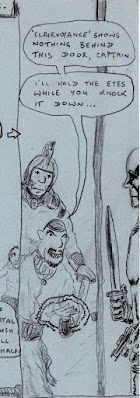On the rare occasions when I've played D&D I usually haven't taken it very seriously. In my defence, that was mostly back in the mid-'70s and the way the early books were written I don't think you were meant to take it seriously. I don't mean the rules; we used the latest iteration of those for the Blood Sword RPG and they work brilliantly. But the default fantasy setting of D&D is a bit sub-sub-sub-Tolkien by way of Monty Python, or so it usually seemed to me.
There were exceptions. I ran a Victorian-era investigative campaign (this was years before Call of Cthulhu, never mind Cthulhu by Gaslight) in which the only magic was 1st and 2nd level. That wasn't played for laughs. Also, when I joined in a game of Blood Sword 5e I not only thought it was brilliantly atmospheric, I actually liked the game system, which was several quantum leaps beyond the D&D of fifty years ago.
Anyway, back to 1976. Invited to join a D&D game by Steve Foster, creator of the Mortal Combat rules, I rolled up a Cugel-like knave called Necromageus Knoll, who soon had a reputation for greed, deceit and treachery. Come to think about it, he was three parts Cugel, two parts Zachary Smith, and one part Tricky Dicky.
The other players seemed to find Necromageus Knoll jolly enough that I put him in a comic strip (inexplicably relocated to the Tekumel underworld, hence the reference to 'Eyes') that lasted a week or two until we moved on to other campaigns. I did something similar but more serious a few years later with this authentic Tekumel write-up.
Having come across that Necromageus Knoll strip just recently, and intrigued to see how my visual storytelling had developed between 1976 and 2008 when I came to write Mirabilis: Year of Wonders (long story short: a lot!) I thought I'd share a bit of it here. Don't worry, I won't quit the day job.




No comments:
Post a Comment